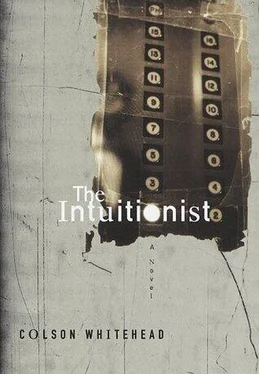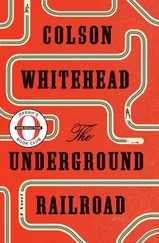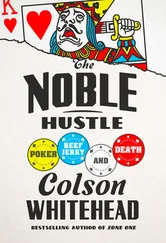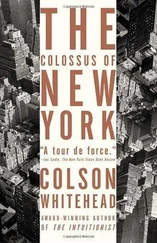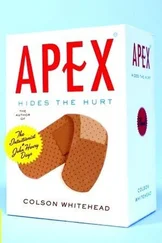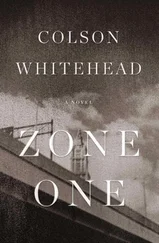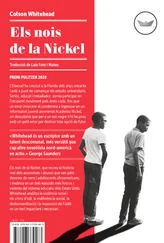If she had known the identity of the man on the last night she saw him, would it have changed her response? On that last night he saw her and waved at her, slowly, communicating all he knew and what she already understood about the darkness. Would it have changed her response to his wave (nothing, not even a nod, the polite thing to do) if she had known the man was James Fulton and that the following morning a hungover janitor would discover his body on the library floor, dead of a stroke, the lantern wick still glowing dully? Probably not. That’s the kind of person Lila Mae is.
* * *
Anyway, slept. In the biggest bed she has ever slept in, swimmable, Lila Mae buoyant despite her negligible body fat (a skinny one, she is). The bed possesses an undertow conducive to dreaming, but she doesn’t remember her dreams when she wakes. On waking, her half-dreaming consciousness segues into a recollection of her visit to the Fanny Briggs building. It was simple: that’s what Lila Mae is thinking about in her room at 117 Second Avenue.
The lobby of the Fanny Briggs Memorial Building was almost finished when she arrived. As if to distract from the minuscule and cramped philosophy of what would transpire on the floors above, the city offered visitors the spacial bounty of the lobby. The ersatz marble was firm underfoot like real marble, sheer, and produced trembling echoes effortlessly. The circle of Doric columns braced the weight above without complaint. The mural, however, was not complete. It started out jauntily enough to Lila Mae’s left. Cheerless Indians holding up a deerskin in front of a fire. The original tenants, sure. A galleon negotiating the tricky channels around the island. Two beaming Indians trading beads to a gang of white men — the infamous sale of the Island. Big moment, have to include that, the first of many dubious transactions in the city’s history. (They didn’t have elevators yet. That’s why the scenes look so flat to Lila Mae: the city is dimensionless.) The mural jumped to the Revolution then, she noticed, skipped over a lot of stuff. The painter seemed to be making it up as he went along, like the men who shaped the city. The Revolution scene was a nice setpiece — the colonists pulling down the statue of King George III. They melted it down for ammunition, if she remembers correctly. It’s always nice when a good mob comes together. The painting ended there. (Someone knocks at the door of her room in 117 Second Avenue, but she doesn’t open her eyes.) Judging from the amount of wall space that remained to Lila Mae’s right, the mural would have to get even more brief in its chronicle of the city’s greatest hits. Either the painter had misjudged how much space he had or the intervening years weren’t that compelling to him. Just the broad strokes, please.
The Deputy Undersecretary of Municipal Construction waddled over from the far wall. He said, “You come to see the elevators?” He had the fatty arrogance of all nepotism hires. Somebody’s nephew, somebody’s sister’s boy.
She nodded.
“Is this going to take long? I’m supposed to go on break now.” On break from what? Only security guards and janitors ever experience buildings like this. Like fraught ships gnashed between the ice, waiting for that warming current still far off, detained in some other part of the world. The rats hadn’t even moved into the building, the roaches still deliberating. A month from now, at this time of day, the lobby will be befouled with citizens. To see a building at this stage, Lila Mae thought, is an honor. The deputy undersecretary was bored and fiddled in his pockets. The muralist’s scaffolding tottered above Lila Mae like a rickety gallows.
“Just show me to them,” Lila Mae said. It will be easy.
Before Lila Mae can re-create her inspection further, the porter opens the door to her room, despite her silence. He holds the silver platter with hands snug in white gloves. He smiles. She pulls the thick red blankets up to her slight chin.
“I’m sorry to disturb you,” he says, “but it seemed a shame to let this nice breakfast go to waste.”
“Thank you,” Lila Mae says. She sits up against the oak headboard. The headboard’s detailed engraving of United’s first lift motor digs into her left shoulder. The man sets the platter across her waist. Eggs, ham, juice. Normally when offered so much food early in the morning (a rare occurrence, to be sure) Lila Mae pecks, and politely moves the food around on the plate to maximize the illusion of being eaten. This morning she is grateful.
The porter’s mouth is quick to smile. He is a tall and broad fellow, and would almost be menacingly handsome if not for the smile. Lila Mae sees he is a strong man, although his strength is wasted on his petite duties; the white uniform fits him well, but he seems trapped by its starched and creased confines. But we take what jobs we can get, Lila Mae thinks. Whatever we can scrabble for. She doesn’t take to it, being waited on by colored people. This is wrong.
He is at the window. “Shall I open the curtains?” he asks.
Lila Mae nods. It’s later in the morning than she thought. The light congeals in globs on the leaves of the old trees in the courtyard. The back walls of the adjoining buildings are decrepit compared to the facades they present to the street, but serve their purpose: to fortify against those who might take the treasures of the courtyard. The garden of old money.
Lila Mae is about to dig into her breakfast when she notices that her green suitcase is ajar across the room, next to an imposing-looking bureau. And empty.
“Don’t worry,” the porter reassures, observing her stare. “It wasn’t me. Mrs. Gravely unpacked your things last night. Mr. Reed thought it would make you more comfortable.” His eyebrows bow. “What is it?” he asks.
“Nothing,” she says. “I’m just tired.”
“You don’t look tired at all,” the porter says. “You’re a vision. Like you’re up and ready to go.”
Hmm. Lila Mae shakes her head and says, “Thanks.”
“I mean it,” he says through a grin. “This isn’t my regular job — my uncle is sick, that’s why I’m here. I’m filling in for him. But if I’d known his job had this many extras, I would have come around here before.” He extends his hand. “My name is Natchez,” he says.
“Lila Mae.”
Hmm.
* * *
“Are you with us, Miss Watson?”
“Yes, sir. I was just thinking that—”
“You are aware this is a timed exam?”
“Yes, sir.”
“Then we’ll begin. 1846.”
“Sir William Armstrong designs and manufactures a hydraulic crane. Erected at Newcastle, the crane utilized water pressure from London’s mains. Armstrong eventually used the same principles in his weighted accelerator.”
“The main function of the pole shader?”
“Is to prevent heating outside the prescribed parameters.”
“A citizen has what chance of being in an elevator misfortune?”
“Injury or fatality?”
“Both.”
“One in three hundred million and one in six hundred fifty million, respectively.”
“Nonmetallic material may be used in T-rails provided what?”
“The rated speed for the car does not exceed zero point seven six meters per second.”
“The three types of safety gears?”
“Instantaneous, Instantaneous with buffered effect, and Progressive. Instantaneous type exerts a rapidly increasing pressure on the guide rails during the stopping period. The stopping time and distance are short. These gears can be employed in cars rated for speeds not in excess of zero point seven six meters per second. Instantaneous type with buffered effect incorporates an elastic system of either energy accumulation or energy dissipation. It generally consists of a system of oil buffers on the lower car frame and safety planks on the guard rails. Effective for rated speeds of up to two point five meters per second. Progressive type applies limited, increasing pressure on the guard rails and is primarily used in Europe on cars with rated speeds of one meter per second or less.”
Читать дальше
